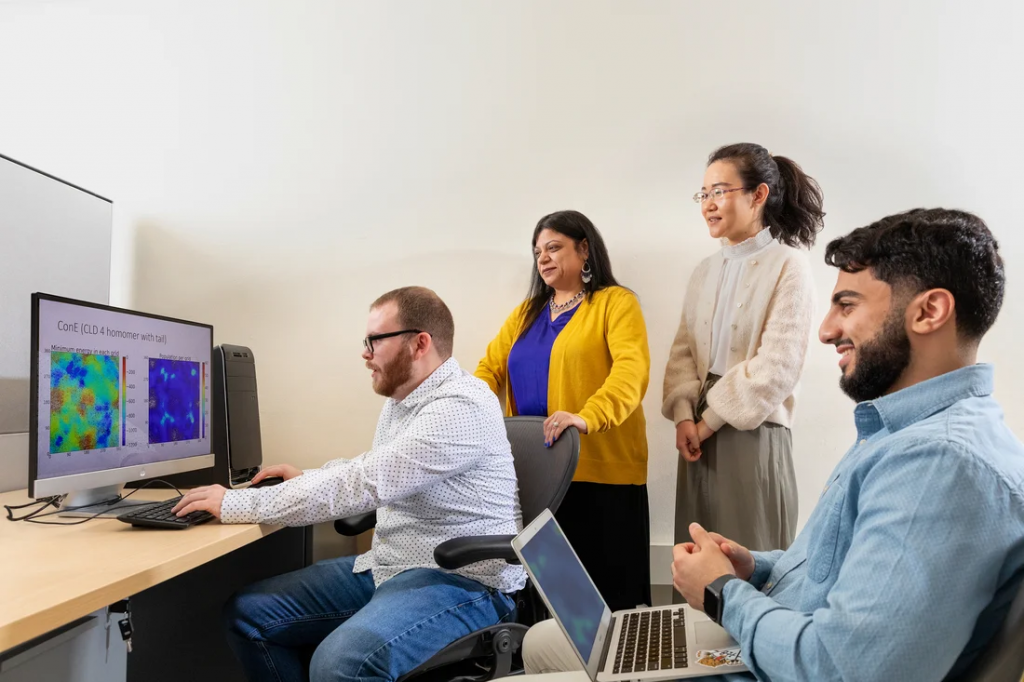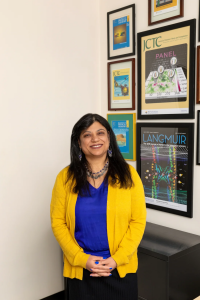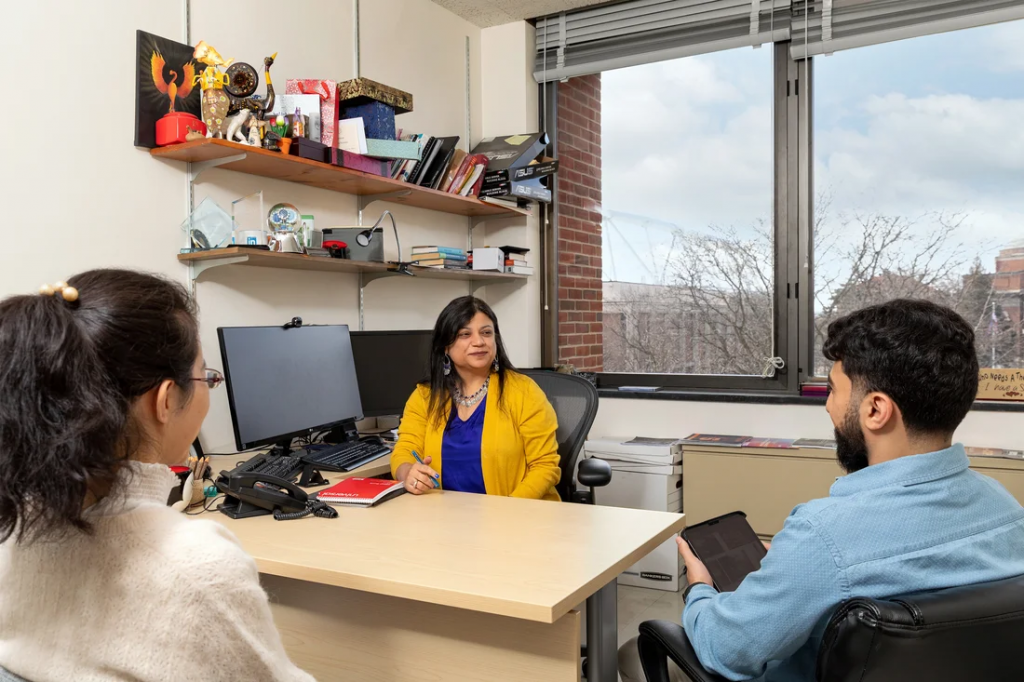For nearly a decade, Shikha Nangia has been unraveling a mystery of the molecular world. At issue is how to successfully permeate the blood-brain barrier, a nearly impenetrable border of cells that protects the brain. As a gatekeeper, the barrier is vital for its role in preventing toxins and pathogens in the bloodstream from infecting the brain, but it also blocks drugs that could potentially target tumors or neurodegenerative diseases such as Alzheimer’s and Parkinson’s from reaching the brain.
With millions of people living with brain-related diseases, Nangia is determined to solve the mystery, knowing success could positively impact the lives of so many people and their families. “We realize there is a way for certain molecules to enter the brain through the bloodstream,” says Nangia, associate professor of biomedical and chemical engineering in Syracuse University’s College of Engineering and Computer Science. “Our research, through computational models, is to create that understanding of the blood-brain barrier at the molecular level so we can design drugs that will go through it.”

Nangia describes her work as basic research. It’s also pioneering and interdisciplinary. An expert in thermodynamics, she focuses on the biophysical aspects and interaction of proteins in the membranes of the cells that form the barrier. She wants to fully understand the barrier’s structure, what triggers it into action and how it operates. Why, for instance, nutrients and other specific molecules, including alcohol, cross through the barrier to the brain. To investigate the barrier’s mechanics, she develops algorithms and simulations, and her work has received funding from the National Science Foundation and National Institutes of Health, among others.

Nangia is especially excited about the idea of advancing to when drugs can be used to treat the brain in a non-invasive manner and avoid surgery. To that end, she’s exploring targeted cancer-drug delivery using nanoparticles (one nanometer is 100,000 times smaller than the width of a human hair); how nanoparticles of different shapes and sizes chemically interact with and move through cell membranes; and how to design virus-like particles for use in nanotechnology and nanomedicine. “The next phase of our research is to test different drug molecules across the blood-brain barrier and learn the fundamentals—the prerequisites for a molecule to go through the barrier,” she says. “Then incorporate that information into a new round of drugs that can be designed to not only surpass the blood-brain barrier, but also to cure Alzheimer’s and other diseases.”
The Joy of Challenging Research
When Nangia first began investigating the issue, she embraced it as an opportunity to use her chemistry background and computer modeling skills. “My initial interest in the blood-brain barrier was the challenge of the problem, and to use my expertise in looking at the chemical aspects of molecules through the computational lens,” says Nangia, who holds a doctorate in chemistry from the University of Minnesota, Twin Cities, and joined the Syracuse University faculty in 2012. “I wanted to use my strengths to attack a problem that had no solution. The challenge of my research gives me joy.”
At the outset, there was no shortage of challenges. “A tough road,” Nangia says, explaining there was no protocol for modeling the blood-brain barrier on a computer. “It took us two or three years to establish ourselves,” she says. “Now we are one of the leading research labs that is studying the blood-brain barrier computationally.”
In modeling the barrier, Nangia zeroed in on a family of proteins at the interface of the cell membranes. She likens these proteins—known as Claudins—to Velcro. They stitch the cells together forming tight junctions, which carry out the gatekeeping duties at the barrier. With the support of an NSF CAREER Award, granted to researchers early in their professional careers, Nangia began developing simulations that explore the molecular structure of the tight junctions. “Everything is happening in a biological system, which is very, very complex,” she says. “But in computational research, it’s key to make good approximations—then you should get the answers you’re looking for.”

Interdisciplinary Collaborations
Nangia has established partnerships with scientists in Germany and Austria, as well as at Harvard Medical School and the University of Michigan. “All the projects we do are in collaboration with folks who are doing it experimentally, providing the feedback,” she says. “It’s an iterative process.” She also works closely with several Syracuse University faculty—including professors James Hougland, Davoud Mozhdehi and Dacheng Ren—at the BioInspired Institute, which supports interdisciplinary research on complex biological systems with the goal of designing and developing smart materials for use in health, medicine and materials innovation. “Part of our work in BioInspired is to bring folks together around big ideas and where to go after big grants and other funding,” says Nangia, who serves on the institute’s executive committee. “I think it has become a fertile discussion ground.” For instance, Nangia and Mozhdehi landed an NSF grant to design a nano-sized biomaterial for use in health care and materials science. “Interdisciplinary research has been the cornerstone of my experience at Syracuse University,” she says.
Nangia’s breakthrough work has also brought her accolades. This year, she was honored with a Rising Star Award by the American Chemical Society’s Women Chemists Committee. She is dedicated to teaching and mentoring and welcomes students to her research team. “When students come to my lab and I tell them we are working toward finding a solution to Alzheimer’s, they perk up and ask how they can contribute because unfortunately all of us know somebody who is in that situation,” says Nangia, who has received numerous honors for excellence as an educator, including a 2017 Meredith Teaching Recognition Award. “I have been able to recruit outstanding students by telling them what their work can lead up to.”
As much as anything, Nangia values her research because of its potential for life-changing impact. As a child growing up in India, she wanted to be a physician, but ultimately gravitated toward research, realizing she could make discoveries that could improve people’s lives. “With my background, I wanted to help design something new that is not yet in our hands, but is in our minds,” she says. “That’s the satisfaction I’m looking for in my research—can my work one day really help a common person? If we can discover a drug molecule that can go through the blood-brain barrier while keeping the barrier intact and then have it clinically delivered and out in the market, that would be the biggest success of our research.”
–by Jay Cox
